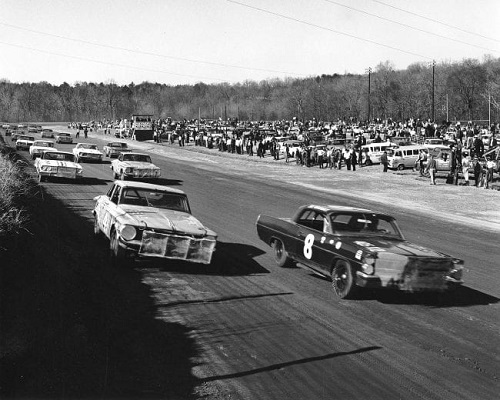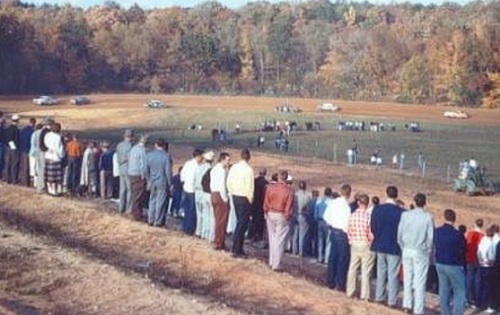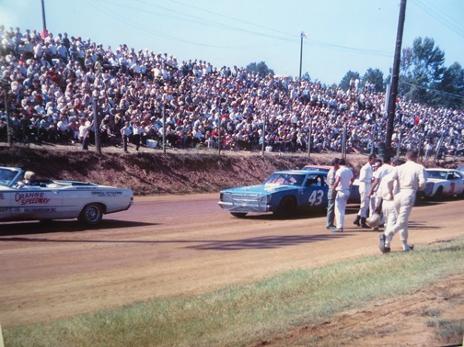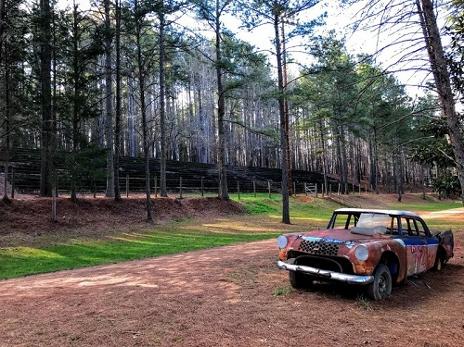OCCONEECHEE SPEEDWAY - HILLSBOROUGH NC
The Occoneechee farm occupied the land in the late 19th century. The farm was named after the Occaneechi Indians that lived in the area in the late 17th century and late 18th century. The landowner, Julian S. Carr, raced horses, and built a half mile horse racing track. Bill France noticed the horse racing track and expanse of open land while piloting his airplane. On the site of the earlier horse track, he built a 0.9-mile dirt track in September 1947, two months before NASCAR was organized. In its earliest days, Fonty Flock and his brothers Bob and Tim dominated the track. Louise Smith became NASCAR's first female driver at the track in the fall of 1949. The speedway hosted all the early stock car
racing legends and was a crown jewel in NASCAR for most of its existence. The track had a 200 lap event around the one mile dirt oval. It was the longest Cup race ever held there. The first Cup race was held in 1949. Bob Flock won the pole, led all 200 laps and beat Gober Sosebee to the line. Glenn Dunaway was third and Fonty Flock fourth. From here on the track usually hosted two races per year. The following year the race was only 100 miles and saw Fireball Roberts get the win. Lee Petty, Fonty Flock and Herb Thomas visited victory lane next. Tim Flock won in 1952; giving all three of the Flock brothers a win in the track first six races. Fonty Flock won again in 1952 and became the first two time winner. In 1957, the track was renamed Orange Speedway. Buck Baker became the first back-to-back winner going to victory lane in 1957 and 1958. In 1968, Richard Petty won the last race held at the track. It was a 167 lap race (150 miles). Petty would romp away from the field and win by seven


laps. James Hylton was second and Neil Castles third. In 32 Cup races at the track there were 18 different winners. The most wins went to Richard Petty, Lee Petty, and Buck Baker with three wins each. Eight drivers won twice. The Convertible series also ran there on four occasions. The first event in March of 1956 saw Curtis Turner beat Joe Weatherly by a slim margin. They returned in October 1956, and once again Turner beat Weatherly; this time by only two car lengths. Finally in 1957; Weatherly would break through and get the win. Curtis Turner would fall out after 95 laps with a broken differential. Weatherly beat Glen Wood by two laps. The final race would come in 1959. Buck Baker led the first 30 laps before falling out with a broken transmission. From there Weatherly would
assume the lead and go on to beat Jack Smith by a lap. The Sunday racing schedule prompted grassroots opposition in Hillsborough when local church leaders began voicing their objections to racing on Sundays, and led to it's demise. After Occoneechee's final race, the track was quickly abandoned. For nearly 30 years, the track sat abandoned falling into disrepair. The loss of the speedway later made Bill France look for a new spot in the area to build a bigger, better, and faster track with speeds in excess of Daytona International Speedway. Eventually he looked towards South Carolina and then eventually Alabama where he built the Talladega Superspeedway which opened a year later where it took Occoneechee Speedway’s date on the schedule. The Occoneechee Speedway site is now heavily forested with pines and sycamores. In 1997, the Classic Homes Preservation Trust


bought the land surrounding the speedway. Over the next ten years, the Trust learned more about the land, Speedway, its history and ties to the community. The grandstands are still visible, as is much of the mile–long oval track. It was placed on the National Register of Historic Places and now comprises 44 acres (180,000 m2) with over 3 miles (4.8 km) of trails. A walking trail was built in 2003 that crisscrosses the clay track. A non-profit local group, The Historic Speedway Group, continues to organize volunteers to renovate historic structures and maintain the track and trails. Later, the Trust would begin to receive help from a group of locals called the Historic Speedway Group that continues to preserve, maintain and rebuild some of the former buildings at the track. It is the only surviving speedway from NASCAR's inaugural season. Today, there are numerous projects and events held at the former speedway site. Efforts are underway to continue to
restore and rebuild the grandstands, pressbox, ticket booth, infield and more. The Historic Speedway Group intends on having a museum with many other speedway artifacts near the site.
Look closely and you'll see the original
grandstands in the background and the
old race car sits in what was the pit area --------->

All Photos copyright and are property of their respective owners
